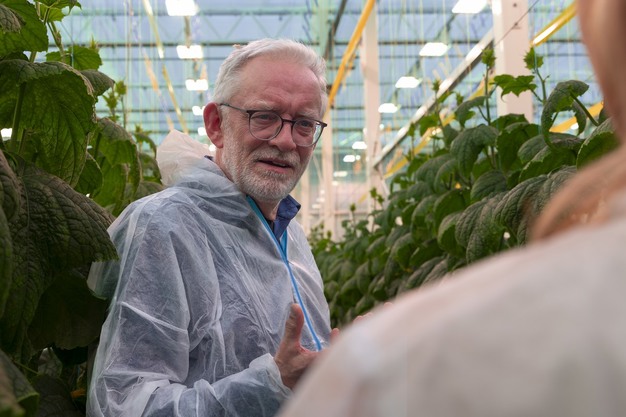A market that evolves continuously needs innovations. Each market seeks certain traits that help them to reach their best potential in terms of production and quality to meet the needs of the entire chain. Rijk Zwaan breeds for new traits to cross in varieties to meet these needs. How do they stay informed about current events in North America while being active in so many different countries?

Eric Bal – Head of Breeding Cucumber at Rijk Zwaan.
Eric Bal – Head of Breeding Cucumber – visits the lighted pickling cucumber crop at the headquarters of Rijk Zwaan in the Netherlands on a sunny Fall day. This is the location where the breeding of most cucumber types starts, such as pickling cucumbers, long, midi, and mini cucumbers. He expertly examines the crop, drawing on years of experience and knowledge.
Rijk Zwaan not only takes good care of the crop but also prioritizes its employees and follows a bottom-up approach. There is a culture of innovation. Together with the other departments, from Breeding to Sales, everyone works together to make a variety a success.
Innovations in the pickling cucumber segment
In the past, Rijk Zwaan's pickling cucumber assortment only contained varieties that were sold mainly in Europe, where the crop is known as gherkin instead of pickling cucumber. In 2005, the company bought a small breeding program from the University of Wisconsin with Bal's involvement.
"We have the opportunity to invest in better greenhouses, research trials, and new, improved equipment. We have started to work in various markets. In addition to breeding varieties for open field, hand harvest, and machine harvest growers, we also have varieties for vertical growing, which is common in the Balkan countries and India," Bal describes.
Is parthenocarpy the future?
Rijk Zwaan only breeds parthenocarpic (seedless) varieties nowadays and stopped with creating new seeded varieties, at least in the pickling cucumber segment. Lenaig Adam, Penélope (Penny), Enriquez Serna, and Ramon de Bont are Breeders of Rijk Zwaan for pickling cucumber, located in the Netherlands. All three of them focus on the parthenocarpic trait, regardless of their segment. They are always working with another breeding colleague, so that trials can be evaluated together. Rijk Zwaan still has one older variety in its assortment, which is seeded.
For the North American market, Rijk Zwaan focuses on hand and machine-harvest varieties with one important trait, which is the predictability of yields and days to maturity. The breeding team focuses on this for North America.
How Rijk Zwaan stays connected with North America
The three pickling cucumber breeders make sure they know what happens in their target markets by staying in close contact with the Crop Specialists and Sales Representatives operating there.
Additionally, Rijk Zwaan has built a new trial station in South Florida, where breeding trials can be conducted during a time of year when it would not be possible in the Netherlands.
 For more information:
For more information:
Rijk Zwaan
Email: info@rijkzwaan.com
www.rijkzwaan.com
